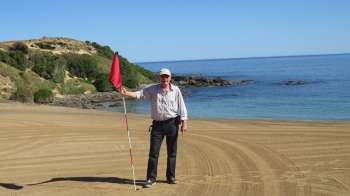So you want to be a golf course designer?
For many of us it sounds like the dream vocation: Golf Course Architect.
In our minds these are the fortunate few who get paid big bucks to travel the world designing golf courses in exotic locations. The reality isn’t quite so glamorous. In fact in Australia, the reality isn’t glamorous at all.
Over the past decade there has been a significant downturn in the golf business in virtually every mature market, including this one. For private clubs, public course operators, tourism groups, retailers, publishers and golf professionals it has become more difficult to keep your business afloat. For the men and women of the Society of Australian Golf Course Architects the last few years have been quite brutal.
The SAGCA is a curious group. Comprised of civil engineers, superintendents, town planners, draftsmen, road designers, professional golfers and even the odd ‘proper’ architect, they come together under the united umbrella of Golf Course Architect and compete with each other for jobs around the country. While their ranks have swelled in recent years, given the scarcity of available work at the moment the competition has become fiercer and more cutthroat.
According to Jeff Blunden from JBAS, around 80 new courses opened in Australia during the 1980s and another 61 in the 1990s. From 2000-2009 the number dropped to 49. There may be fewer than 25 new courses built this decade. Remodeling work has also slowed as clubs battle cash flow issues and fight to retain existing members. It would be fair to say that making a living from course design in Australia has never been more difficult.
It has been fashionable over the past few decades for those passionate about golf course design to start out with a larger signature company, and then branch out on their own once they have established their credentials. Across the globe these larger companies are now downsizing, making it both more difficult to get your start in the business but also more daunting when you do decide to fly solo. Those minor jobs that larger companies once ignored are now hotly contested and harder for smaller firms to win.
One man who understands such challenges well, is independent designer Richard Chamberlain. Chamberlain spent 20 years working productively for Graham Marsh and Ross Watson, before establishing his own business in 2008 right as the bottom fell out of the market. He has never seen the golf economy worse, and believes there is not enough design and construction work to be shared around. It’s a view echoed by others.
Chamberlain’s main challenge since setting up his business has been convincing clubs to look beyond the established names and big signature firms. ‘I felt like I had worked through a long, intensive 20 year apprenticeship prior to starting my business’ says Chamberlain, ‘and there is no doubt that I have all of the attributes and skills needed to build a golf hole. It’s simply a matter of proving to new clients that this can be done at least on par, if not better, than the established firms.’
Another independent designer formerly employed by a signature firm is Bob Harrison, who spent more than 20 years with Greg Norman Golf Course Design before setting up his own business in 2009. Harrison was lead designer for the Norman company and is in a different boat to Chamberlain, having already establishing himself as one of this country’s preeminent designers. Nevertheless, Harrison describes the current golf environment as ‘brutal’ and is concerned for young designers starting out in the business. He says that he would have ‘no chance’ of surviving in this environment if trying to establish himself from scratch and has no doubt that were he starting his career again it would be in a different field.
Harrison fondly recalls his earlier days in the business when young wannabe architects could get starts here or overseas in the United States and Europe. Those options no longer exist, and he believes the only chance they have now to establish themselves is to join a company that is active in Asia. While Chamberlain is reluctant to step into Asia, following a bad first experience in China, his contemporary Harley Kruse is diving in headfirst.
Like Chamberlain, Kruse has more than 20 years experience in golf course design, but part of that was spent living in China whilst working for Ross Perrett and Peter Thomson. He later worked with Harrison at Greg Norman Design, where he played a leading role in company projects across Asia. When Norman closed his Sydney office Kruse formed a new Asian-specific design partnership with Bob Harrison, and in a little over two years the pair have signed up three new 18-hole projects in China, with other enquiries having come from across the region. As Kruse points out, ‘the market in Asia knows that on notable projects such as Nirwana Bali, Dunes Course at Danang, and the Norman Course at Mission Hills it was Bob and I who actually drew the designs and got those courses delivered on the ground. As others have said, it’s the same design service now, but without the ‘blond guy’.’
While Kruse would love to work more at home, Asia is the region where he is best known and also the region with growth. That’s the same reason another young, passionate, Australian designer, Ben Davey, is also focusing his attentions there in order to survive. Five years ago Davey formed a partnership with veteran PGA professional Bob Shearer and they started by working almost exclusively in China. They do have a few smaller ongoing jobs here in Australia but as Davey says, ‘if we relied entirely on income from Australia, I would be in the poor house.’
As for future prospects, Davey believes that new projects here will be hard fought for and warns young designers that ‘trying to focus entirely on work in Australia is very risky. I can't see a boom in golf construction like we saw 10-15 years ago happening again for a very long time’
There is no doubt that working in Asia brings its own challenges and as Davey points out it is much more difficult to establish yourself than many people realise. It’s clearly not for everyone, and those designers within the SAGCA who are not active there are finding it more and more difficult to survive. A number have left the profession all together, including Justin Trott who spent 17 years working as a designer for Thomson and Perrett. Trott has more experience in design and construction than most architects, but now heads the landscape division of the Turnpoint Group. He says the difficulties experienced over the past couple of years have been unprecedented and he left the industry because work had dried up and he felt it was time to do something different. ‘Make no mistake’ says Trott, ‘times are very, very tough for struggling architects at the moment. When I first started in the mid 90s there were only a handful of practicing golf architects – now there are well over 50 and there simply aren’t enough jobs to go around.’
Harrison isn’t surprised that young designers are leaving the profession, and in fact is ‘surprised that so many have stuck with it in Australia.’ He describes course design as ‘a sad old business here’ and doesn’t believe that designers trying to establish themselves in this country can survive. The market is that tough. Chamberlain agrees, and says there simply isn’t enough work to be shared around, adding that ‘unless there is a sudden turnaround in the volume of work we will lose more designers.’
He points to the recent RACV Royal Pines tender process as a sign of the problems faced by up-and-coming designers. ‘Every designer here, and beyond, put their hand up to be considered’ says Chamberlain, ‘but the short-list of 5 was quickly trimmed, without interview, to the two signature companies, Thomson Perrett and Graham Marsh.’
Although disappointed to have missed out, Chamberlain believes that golfers are slowly learning the nuances of good and poor design practices and he has hopes that, ‘as clients become better educated, the mundane, “assembly line” type of design becomes more obsolete.’ That hasn’t happened yet, but for those independent designers willing to stick it out and try to make a living out of the business it’s about the only hope they have.
There seems no doubt that over the next few years there will be fewer golf course architects operating in Australia, as projects continue to dry up and some of the elder statesmen of design retire. Provided we can keep talented and passionate young people in the business, this inevitable rationalisation may not be a bad thing. The new breed of designer is typically eager, competitively priced and much more hands-on than the larger signature firms. These are the guys that used to do the design work for these firms anyway, but now their own name is on the plan. As Chamberlain points out, ‘word of mouth is an extremely important marketing tool and in an effort to build and strengthen my brand I need to ensure that I walk away from a project with the client completely satisfied.’
Customer satisfaction hasn’t always been a primary concern for golf course designers, but it now sits right near the top of their list of priorities – apparently beneath mere survival.
Darius Oliver, Architecture Editor
Back to NewsMore News
The Cliffs Kangaroo Island Announces Preview Play in early 2026
Major milestone for stunning new destination course with preview play available from January 2026
Who Really Designed Cape Wickham Links?
AGD ranks Cape Wickham #1 in Australia & interviews Duncan Andrews to get full story on course design
Cape Wickham Links – The Inside Design Story
Co-designer Darius Oliver reveals the truth behind the design of Australia’s premier modern golf course
2025 Karrie Webb Series scholars announced
Two young golfers set to follow in the footsteps of some of Australia's best golfers after winning 2025 scholarships




